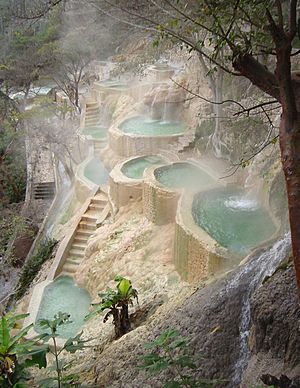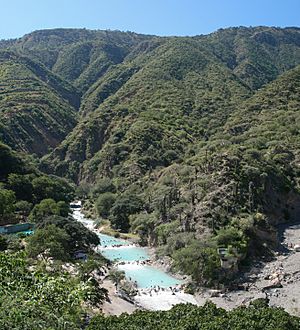Tolantongo facts for kids
Tolantongo is a super cool natural water park and resort in a deep canyon in Hidalgo, Mexico. It's about 1.5 hours northwest of Pachuca and a few hours north of Mexico City. The closest village is called El Cardonal.
The name Tolantongo comes from the Nahuatl word "Tonaltonko," which means "Home where it feels warm." It got its current name by accident when a magazine misspelled it in 1975!
The river that flows through the canyon is also called Tolantongo. Its water is wonderfully warm and has a unique color from minerals it picks up inside the mountain. The water comes from channels deep inside the mountain, heating it to about 20 degrees Celsius (68 degrees Fahrenheit). Even on a chilly day, the river is perfect for swimming!
You can get to Tolantongo by bus from Mexico City to Ixmiquilpan, then take a smaller bus. Many visitors also drive their own cars.
Contents
Welcome to Tolantongo!
The Tolantongo resort is built at the bottom of a steep canyon, with walls as high as 500 meters (about 1,640 feet)! It has three hotels and lots of warm pools. The main attractions are two amazing grottos (caves) at the end of the canyon. A warm river flows out of these caves and down the canyon floor.
The biggest grotto is about half the size of a tennis court, with a ceiling up to ten meters (33 feet) high. Above this grotto is a "tunnel," which is a smaller cave about 15 meters (50 feet) deep. Warm water showers down on anyone who goes inside! Around these openings, warm waterfalls tumble down the canyon walls. Here, you can try exciting activities like hiking, rappelling (climbing down ropes), and spelunking (exploring caves).
The resort is open every day. Besides the hotels and campgrounds, it has pools, restaurants, and even a grocery store.
Exploring the Amazing Caves
There are two main caves to explore: the big grotto where the river starts, and the "tunnel" above it. The main grotto is a karst cave, which means it was formed by water dissolving rock. Inside this cave, it gets noticeably warmer, and you'll see cool rock formations like stalactites and stalagmites.
Just outside the main grotto, there are natural pools where you can relax in the shallow river as the water flows by. The "tunnel" is named for its shape – it's narrow and about 15 meters (50 feet) long. Inside the tunnel, warm water sprays from the walls and ceiling, making it feel like a natural steam bath! There's even a small pool inside the tunnel where you can swim. In both caves, you can hear the echoes of the waterfalls inside the mountain.
Other Fun Water Spots
All along the canyon walls, you'll find man-made, semi-circular "chapoteaderos," or splashing pools. These are created by blocking small warm springs. Many of them are shaded by trees, so you can relax in the warm water and enjoy the canyon views at the same time.
There's also a natural spot called La Gloria, which has three pools that flow down one of the canyon walls. What's cool is that the top pool is warm, the middle one is cool, and the bottom one is warm again! Water trickles and streams all around these pools. You can also find camping and restrooms near La Gloria.
Nature and Wildlife
Tolantongo is in a semi-desert area, surrounded by amazing rock formations shaped by water and geological forces. You can see layers of rock that have folded over time, creating unique shapes. The high peaks here are often covered in mist.
The hills above the canyon are home to cacti and other plants that like dry weather. Higher up, you'll find pine trees. This rugged area has a lot of different plants and animals. Some plants you might see include yucca and mesquite trees, and tall cacti called "viejitos" (little old ones) because their top spines look like gray hair! There are also lots of maguey plants, which have been used for centuries to make a traditional fermented drink called pulque.
Animals that live here include raccoons, greater roadrunners, hooded skunks, white-nosed coatis, and white-winged doves. This area has also been home to different ancient groups of people like the Otomi, the Mexica, the Toltecs, and the Tepehua.
To reach the resort, you drive down an unpaved road that winds along the canyon wall. As you get to the bottom, the plants change from desert-like to more tropical. This is because of all the water and the warm, humid air from the river and waterfalls. In some places, the plants are really lush and green! The beauty of this area is so famous that a Mexican soap opera (called a "telenovela") even filmed some romantic scenes here.
How Tolantongo is Managed
The Tolantongo resort is managed in a very special way. It belongs to a group called the "Cooperative Ejido Society of the Tolantongo Grottos." This group was started 30 years ago by 112 families who own the land together. This type of shared land is called an ejido.
All the workers at the resort come from these ejido families. They even dress similarly, no matter what their job is! While some jobs pay more, these higher-paying roles are rotated among the family members. Each family gets to vote on important decisions for the ejido. This project started in the 1970s without any outside help from experts or the government, and it still runs that way today! A part of the resort's earnings is put back into improving the place. This unique way of working together has helped the families keep the resort and the land around it in its beautiful natural state.
Most of the canyon area is owned by this group, but two different ejidos share the land. Each ejido owns one side of the canyon. The side with La Gloria is owned by another ejido, and they charge a separate fee to enter their area.
See also
 In Spanish: Grutas de Tolantongo para niños
In Spanish: Grutas de Tolantongo para niños
- Rzedowskia tolantonguensis, a Mexican plant named after this area




